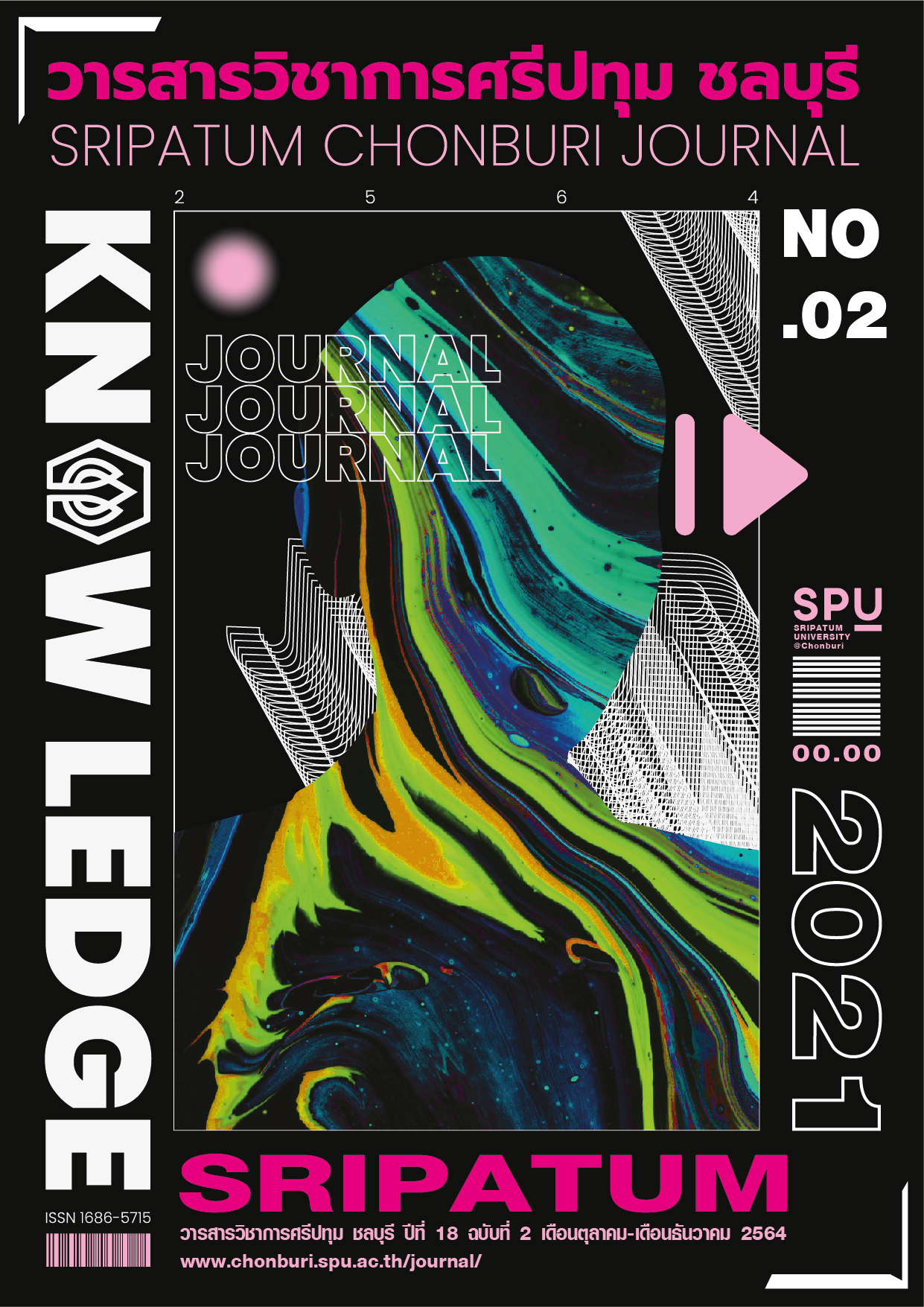TRANSPORT GUIDELINES, MARKETING, MEDIA USAGE FOR SELLING PRODUCTS OF BEHIND THE ROMAN TEMPLE COMMUNITY CHANTHABURI PROVINCE UNDER THE CORONAVIRUS DISEASE 2019 SITUATION
Keywords:
digital media, the community behind Roman temple, Chanthaburi province, Coronavirus 2019Abstract
The objectives of this research are as follows: 1) the level of factors about using the tool digital communication potential attraction creative economy and the efficiency of using digital media to promote tourism in Chanthaburi province under the coronavirus disease 2019 (COVID-19) situation, 2) causal factors affecting the efficiency of using digital media to promote tourism in Chanthaburi province under the coronavirus disease 2019 (COVID-19) situation, and 3) propose marketing promotion guidelines from using digital media to promote products of the community behind Roman temple, Chanthaburi province, under the coronavirus disease 2019 (COVID-19) situation. Mixed research methodology. The research tools included questionnaires and interview form the research instrument was a questionnaire, which collected data from a sample of visitors who purchased the products of the Roman abbey community, Chanthaburi province. A total of 384 participants were analyzed by frequency distribution, percentage, mean, standard deviation, skewness, kurtosis and structural equation model analysis techniques. The results showed that the sample group saw that the community behind the Roman temple, Chanthaburi province was a high level of use of digital communication tools, a high level of tourism potential and a high level of creative economy. To promote tourism in Chanthaburi at a high level. Causal factors on the efficiency of using digital media to promote tourism in Chanthaburi province under the coronavirus disease 2019 (COVID-19) situation at a statistically significant level of .05, it was found that the factors related to the use of digital communication tools potential attraction and creative economy. There was a direct correlation to the efficiency of using digital media to promote tourism in Chanthaburi. Travel in Chanthaburi is good and acceptable accounted for 82.40%. Marketing promotion approaches from using digital media to promote products of the Roman temple community, Chanthaburi province under the coronavirus disease 2019 (COVID-19) situation, including the use of digital communication tools potential attraction and creative economy efficiency of using digital media to promote tourism in Chanthaburi province: 1) using digital communication tools to build awareness and image. There is a marketing promotion by informing the promotion. Promotion through social media, 2) create a unique and attractive identity in a place or community culture, 3) preserving the identity of the community's way of life through the history of the community as a story as a community product and revitalize the way of life of a traditional commercial district product development, and 4) outside-in strategy contributes to sustainable tourism processes in the community and leads to the development of income generating channels.
References
[2563, 12 มีนาคม].
กังสดาล ศิษย์ธานนท์ (2558). รูปแบบการดำเนินชีวิต รูปแบบการใช้สื่อออนไลน์ และความตั้งใจซื้อสินค้าและบริการด้านการท่องเที่ยวของนักท่องเที่ยวชาวไทย. วิทยานิพนธ์
ศิลปศาสตรมหาบัณฑิต สาขาวิชานิเทศศาสตร์และนวัตกรรม, คณะนิเทศศาสตร์และนวัตกรรมการจัดการ สถาบันบัณฑิตพัฒนบริหารศาสตร์.
ชนกพล ชัยรัตนศักดิ์ดา. (2557). ประสิทธิภาพของสื่อประชาสัมพันธ์การท่องเที่ยวในประเทศไทย. สารนิพนธ์นิพนธ์นิเทศศาสตรมหาบัณฑิต สาขาวิชาการประชาสัมพันธ์,
คณะนิเทศศาสตร์ มหาวิทยาลัยศรีปทุม.
ณัฐวดี พัฒนโพธิ์. (2560). การพัฒนาศักยภาพกลุ่มแปรรูปผลิตภัณฑ์จากต้นกก บ้านโนนนาค ตำบลบัวบาน อำเภอยางตลาด จังหวัดกาฬสินธุ์. Governance Journal, 6(2),
หน้า 120-132.
ธนัญกรณ์ รักษาคำ. (2559). ประสิทธิภาพและความคาดหวังที่มีต่อประสิทธิภาพของสื่อประชาสัมพันธ์ขององค์การบริหารส่วนตำบลคลองตำหรุ. วารสารวิชาการศรีปทุม ชลบุรี,
12(6), หน้า 98-105.
พจน์ ใจชาญสุขกิจ. (2555). เมื่อโลกเปลี่ยน: ถึงจุดเปลี่ยนแห่งการสื่อสาร. Communication Change, 1(1), หน้า 64-75.
พรทิพย์ พิมลสินธุ์. (2551). การวิจัยเพื่อการประชาสัมพันธ์ (พิมพ์ครั้งที่ 6). กรุงเทพฯ: สำนักพิมพ์มหาวิทยาลัยธรรมศาสตร์.
พรศิริ วิรุณพันธ์. (2564). การพัฒนาศักยภาพทางการตลาดตามแนวคิดเศรษฐกิจสร้างสรรค์กลุ่มทอเสื่อกก อำเภอศิลาลาด จังหวัดศรีสะเกษ. วารสารศิลปศาสตร์และวิทยาการ
จัดการ, 8(1), หน้า 15-29.
รพีพรรณ รัตนวงศ์นรา. (2563). 7 วิธีเว้นระยะห่างทางสังคม Social distancing ต้านภัย COVID-19 (ออนไลน์). เข้าถึงได้จาก:
https://www.rama.mahidol.ac.th/th/infographics/172 [2563, 5 เมษายน].
รัฐนันท์ พงศ์วิริทธิ์ธร และกัญญากาญจน์ ไซเออร์ส. (2559). แนวทางการพัฒนาการท่องเที่ยวจังหวัดเชียงใหม่ ตามทัศนะของนักท่องเที่ยวเพื่อความยั่งยืน. วารสารวิชาการ
มหาวิทยาลัยธนบุรี, 10(22), หน้า 60-66.
วสันต์ วรเจริญ และคณะ. (2561). การวิจัยและพัฒนาคุณภาพผลิตภัณฑ์วิสาหกิจชุมชนในกลุ่มทอเสื่อกก ตำบลคำไผ่ อำเภอไทยเจริญ จังหวัดยโสธร. สักทอง: วารสาร
มนุษยศาสตร์และสังคมศาสตร์ (สทมส.), 24(ฉบับพิเศษ), หน้า 55-68.
วิกรม วงษ์สุวรรณ์ และคณะ. (2561). รายงานการวิจัยฉบับสมบูรณ์ โครงการ Innovation hubs เพื่อสร้างเศรษฐกิจฐานนวัตกรรมของประเทศ ตามนโยบายประเทศไทย 4.0
กลุ่มเรื่องเศรษฐกิจสร้างสรรค์ (creative economy): โครงการถ่ายทอดเทคโนโลยีเพื่อพัฒนาผลิตภัณฑ์ Premium OTOP เสื่อกก จังหวัดมหาสารคาม. มหาสารคาม:
คณะสถาปัตยกรรมศาสตร์ ผังเมือง และนฤมิตศิลป์ มหาวิทยาลัยมหาสารคาม.
วิภาดา พิทยาวิรุฬห์ และณักษ์ กุลิสร์. (2557). การตอบสนองต่อสื่อดิจิตอลของผู้บริโภคในการเข้าถึงข้อมูลทางการตลาด. วารสารบริหารธุรกิจศรีนครินทรวิโรฒ, 5(1),
หน้า 80-96.
ศุภชัย เหมือนโพธิ์. (2559). การพัฒนาศักยภาพผู้ประกอบการชุมชนตามแนวคิดเศรษฐกิจสร้างสรรค์. วิทยานิพนธ์ปรัชญาดุษฎีบัณฑิต สาขาวิชาพัฒนศึกษา, บัณฑิตวิทยาลัย
มหาวิทยาลัยศิลปากร.
Aaker, David A. (1996). Building strong brands. New York, NY: Free Press.
Diamantopoulos, Adamantios, & Siguaw, Judy A. (2000). Introducing LISREL: A Guide for the uninitiated. London, UK: Sage.
Cochran, William G. (1977). Sampling techniques (3rd ed.). New York, NY: John Wiley & Sons.
Collier, Alan, & Harraway, Sue. (1997). Principles of tourism. Auckland, New Zealand: Longman.
Cronbach, Lee J. (1990). Essentials of psychological testing (5th ed.). New York, NY: Harper Collins.
Hair Jr, Joseph F., et al. (2010). Multivariate data analysis (7th ed.). Upper Saddle River, NJ: Prentice Hall.
Hawkins, Del I., Best, Roger J, & Coney, Kenneth A. (2001). Consumer behavior: Building marketing strategy (8th ed.). New York, NY: McGraw-Hill.
Joreskog, Karl G., & Sorbom, Dag. (1993). LISREL 8: Structural equation modeling with the SIMPLIS command language. Skokie, IL: Scientific
Software International; Lawrence Erlbaum Associates.
Kline, Paul. (1994). An easy guide to factor analysis. New York, NY: Routledge.
Middleton, Victor T. C. (1989). Marketing implications for attractions. Tourism Management, 10(3), pp. 229-232.
Phatcha, Piyapong, Phetchanchai, Chawalsak & Kaosa-ard, Chadamach. (2020). Factors affecting tourists decision on health tourism in the area
Eastern Seaside Province Group. Journal of Innovation and Management, 5, pp. 87-102.
Saris, Williem E., & Stronkhorst, L. Henk. (1984). Causal modelling in non-experimental research: Introduction to the LISREL approach. Barcelona,
Spain: Sociometric Research Foundation.
Thomson, Steven K. (1992). Sampling. NewYork, NY: John Wiley & Sons.
Tiapaiboon, Phattanakan. (2014). Potential of community based ecotourism at Hua–Noun Wat community, Mae-Tom sub-district, Bangkum district,
Songkla province. Master Thesis of Science in Environmental Management, Prince of Songkla University, Thailand.
Downloads
Published
Issue
Section
License
บทความทุกบทความเป็นลิขสิทธิ์ของวารสารวิชาการศรีปทุม ชลบุรี



